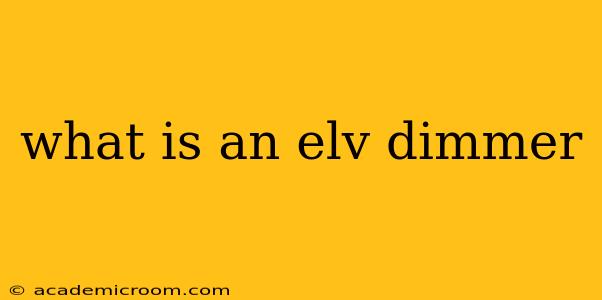Electronic Low Voltage (ELV) dimmers are sophisticated devices designed to control the brightness of low-voltage lighting systems, typically those operating at 12 volts or 24 volts. Unlike traditional incandescent dimmers, ELV dimmers use electronic circuitry to smoothly modulate the power supplied to the lights, offering a much more refined and precise dimming experience. This makes them ideal for a variety of applications where smooth, precise control of lighting is crucial.
This article will delve into the specifics of ELV dimmers, addressing common questions and concerns surrounding their functionality and application.
What are the benefits of using an ELV dimmer?
ELV dimmers offer several advantages over traditional incandescent dimmers, especially when used with low-voltage lighting systems like LED strip lights, halogen lamps, and some types of MR16 bulbs. These benefits include:
- Smooth dimming: ELV dimmers provide a far smoother dimming curve compared to incandescent dimmers, avoiding the flickering or pulsing often seen with cheaper alternatives. This results in a more aesthetically pleasing and comfortable lighting experience.
- Compatibility: They are specifically designed for low-voltage lighting, ensuring compatibility and preventing damage to your lights. Incandescent dimmers often can't handle the unique electrical characteristics of low-voltage systems.
- Precise control: ELV dimmers allow for finer control over the brightness levels, enabling you to achieve the perfect ambiance for any situation.
- Extended lifespan: By reducing the voltage fluctuations and stress on the lights, ELV dimmers can contribute to a longer lifespan for your low-voltage lighting fixtures.
- Energy efficiency: While not as directly impactful as with higher-voltage systems, ELV dimmers still contribute to energy savings by allowing you to reduce the power consumption of your lights when needed.
What types of low-voltage lighting are compatible with ELV dimmers?
ELV dimmers are primarily designed for use with low-voltage LED strip lights, halogen lamps (often MR16 or GU10), and certain types of low-voltage LED bulbs. Always check the specifications of your lighting fixtures before purchasing an ELV dimmer. Some LED lights are not dimmable at all, and using an incompatible dimmer can damage the lights or the dimmer itself. The packaging or manufacturer's specifications for your lights should clearly indicate whether they are dimmable and what type of dimmer is required.
How does an ELV dimmer differ from a standard dimmer switch?
The key difference lies in the voltage they handle and their internal circuitry. Standard dimmers are designed for higher voltage systems (typically 120V or 230V), while ELV dimmers are specifically built for low-voltage applications (12V or 24V). Standard dimmers often use simpler, less precise methods of dimming which can be unsuitable for delicate low-voltage LEDs. ELV dimmers use sophisticated electronics to deliver a smooth and controlled dimming experience crucial for maintaining the life and performance of low-voltage lighting.
Can I use an ELV dimmer with high-voltage lights?
No, you absolutely should not use an ELV dimmer with high-voltage lights. Doing so is incredibly dangerous and will likely damage the dimmer and possibly cause a fire. ELV dimmers are only designed to handle the low voltages specified and attempting to use them with higher voltages will severely overload and potentially destroy the dimmer's internal components.
What are the potential problems with using the wrong dimmer?
Using the wrong dimmer with your low-voltage lighting can lead to several issues:
- Flickering or pulsing: Inconsistent dimming can create an unpleasant strobe effect, making the lighting uncomfortable to use.
- Buzzing or humming noises: Poorly matched dimmers can generate irritating sounds from the lights.
- Premature light failure: Incorrect dimmers can overheat or damage low-voltage LEDs, shortening their lifespan significantly.
- Complete light failure: In some cases, using an incompatible dimmer can completely disable the lights, rendering them unusable.
Understanding the nuances of ELV dimmers and selecting the correct one for your low-voltage lighting system is crucial for ensuring both safety and optimal performance. Always consult the specifications of your lighting fixtures and the dimmer before installation.
